The Defence Science and Technology Laboratory (Dstl) has today confirmed new investment that will increase scalable protection options for the UK’s armoured land vehicles.
Funded by the British Army, this press release explains that the investment of £15 million over three years will enable Dstl to deliver the follow-on phase of the successful Icarus Technology Demonstrator Programme (TDP).
“The Icarus TDP, through Chief Scientific Advisor (CSA) funding, developed and demonstrated the Modular Integrated Protection System (MIPS) Open Architecture Standard (the MIPS standard) to Technology Readiness Level 5 (TRL 5). This new investment will exploit and build on the MIPS standard to demonstrate a modular, flexible Active Protection System (APS) at high maturity (TRL 7).”
According to the press release, the next stage of MIPS will enable the UK to continue to develop future capabilities, with advances through to 2040 to include:
- Improved sensors – multi-spectral devices are combined with increasingly sophisticated fast signal processing
- Improved information processing – including data fusion and artificial intelligence (AI)
- Improved effectors – current counter-munition and directed energy technology projects deliver precise effects to defeat a wider range of threats
- Improved high-speed directors – compact and affordable energy storage and motor drive technologies
- Improvements in electronic infrastructure component technologies – exploiting safety and security features being developed elsewhere for industrial robotic and autonomous systems
Minister for Defence Procurement, Alec Shelbrooke, was quoted as saying:
“Our Armed Forces keep us safe around the clock and it’s incumbent upon us to do all we can to protect them and adapt to future threats. The war in Ukraine has highlighted the importance of well-protected armoured vehicles. We are supporting the Army to modernise and remain at the forefront of cutting-edge capabilities. This is an important step forward in researching the latest technology to improve protection for armoured vehicles, helping them prevent and repel attacks from the ground and air.”


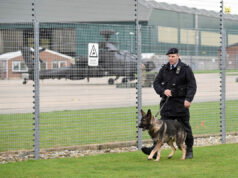

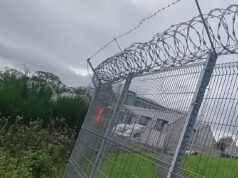

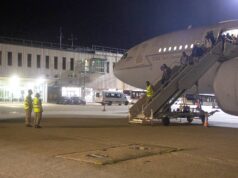

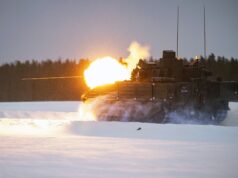
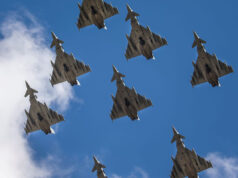
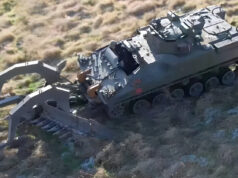


Well I suppose it indicates that there is a recognition that work needs to be done in this area. Doesn’t seem like much money though but I suppose it is a start.
I would be surprised if this is the start of British research into APS for land vehicles
The other day a T90M was captured intact by the Ukrainians in the kharkiv region, but what really caught my eye was that it was covered in Nakidka radar-absorbent and heat-insulating material. Ok maybe not an active defence sysytem, but it does fall into the cat of a passive one.
The kit inside the tank doesn’t look Orc made? Looks more French if I was to guess?
A much more knowledgeable bloke than I actually answered that question of yours:
I though it was known that the French were the gun sight suppliers for the T90?
They were, but sanctions placed on Moscow after 2014 ended that (pretty sure I read somewhere the french continued to supply them for a long while) and so the Russians looked in house, on that note I read ana rticle somewhere that since feb, Moscow has been hovering up silcon chips on the black market in which to try and ensure it has enough for the future.
They were originally but after 2014 Thales etc pulled out and Russia has made its own home grown variant. Probably a pair of ww2 binoculars wrapped in a fancy box😂😂😂
Heard Safran mentioned certainly in some sort of joint venture.
How long before that ends up Stateside and be crawled over and pulled-apart forensically 😏
Sean wrote:
Hopefully yesterday, but to be fair the T90M is simply an evolutionary upgrade from the T90A which is the same to the T90 which is the same to the T72
The T90 was simply a rebadging of the T72 after the debarkle of Chenhnya in 1994
Not many were produced and an order by india (T90S) for around 1000 saw production continue, but the indian order demanded a new welded turret (with a small bustle at the back) in place of the cast turret of the T72 and T90, The Russians impressed by the new turret lenghened that at the back in which to produce the T90M
https://i.postimg.cc/bvxFfSff/olp.jpg
The new turret bustle is supposed to contain 10 rounds- add a new iteration of the 125mm gun a revamp of the auto loader which is lifted higher allowing longer 1 piece ammuntion to be used, new electronics and a new engine.. Personally I feel the spooks will be more interested in the ERA, and electronics especially the network centric data transfer system (first seen in the T90A) which allows tanks to share data and images to other tanks and supporting units.
Indeed. I don’t think the Russians have much that we do not already have but the interest will be in understanding Comms (so they can be hacked) and understanding the weak points and strengths etc. The tech itself is not going to be of much interest. The other thing they will be interested in will be the serviceability of the equipment.
I’d have thought they would want to put a western tank crew in it, then run it around a tank testing ground and range for a while, then ask the crew what was better/ worse than a western vehicle. Then that info can help inform tactical operations against them?
Yes, but really doesn’t make for nearly as exciting a screenplay as ‘Hunt for Red October.” 😉
Aha, “Hunt for Red Tom’s Tractor”
🤣🤣🤣
“The Icarus TDP, through Chief Scientific Advisor (CSA) funding, developed and demonstrated the Modular Integrated Protection System (MIPS) Open Architecture Standard (the MIPS standard) to Technology Readiness Level 5 (TRL 5). This new investment will exploit and build on the MIPS standard to demonstrate a modular, flexible Active Protection System (APS) at high maturity (TRL 7).”
Takes me back to sitting through highly complicated PowerPoint presentations. We used to call it ‘Bullshit Bingo”...
My thinking exactly, the IDF after the war in Lebanon in 2006 brought on line Trophy in 2009 (13 years ago) it has a 100% record in taking out attacking ATGM.
In 2016 the Uk placed a £7.6 million contract with QinetiQ to evaluate the Hensoldt Multifunctional Self-Protection System (MUSS) soft-kill APS which is currently deployed on the German Army PUMA Armoured Infantry Fighting Vehicle (AIFV). MUSS is a soft kill APS and jams the incoming threat before it impacts the platform.
In June 2017, the UK Defence Science and Technology Laboratory (DSTL) awarded the ICARUS TDP to Leonardo UK with a value of £10M to go a stage further Which saw the first phase successfully completed exactly a year ago
Now the MOD has handed over £15 Million for another 3 years of …research. To which I have to ask the question, why is the MOD dragging its feet over numerous APS systems already in service (or ordered) around the world which in light of events in the Ukraine is a must purchase especially when our armour does not have the fat to take any losses on the battlefield. It beggars belief that the UK has actually dragged this out for 6 years with another 3 years to be added onto that.
Perhaps you are confused, they appear to be talking about future “effectors” including lasers, not current projectile APS.
I do believe those will be incremental add on’s which will combat emerging technologies as they come on line, and currently death ray capable laser weapons are still only found on the small screen, in sci fi books and the death stare my better half gives me when i mess up. My point is how long do you keep carrying out research on an APS system which has been in operational use since 2009 and which others
China: GL5 Active Protection System
Korea: KAPS (Korean Active Protection System)
India: LEDS
Turkey: Akkor (countermeasure
Russia: Numerous
Israel: Iron fist/Trophy
Holland: Iron Fist
US: Trophy
Germany: Trophy
Are already using or close to using. On that note regards countermeasures against lasers the Russian Shtora-1 Soft kill system deploys 12 aerosol grenades on been lazed , the smoke screen they produce is specially designed to block lasers and thermal imaging devices. It was been in use for 34 years. My gripe was and still is the protracted time frame for the British MOD to get something into service.
Do u think they are maybe trying to get a uk only system developed? Better, faster, modular, cutting edge, threat suppressor.
MS wrote:
I thought Leonardo the company leading the project is italien
Leonardo has significant UK operations
…including making helicopters in Yeovil.
These defence companies are multinational and have subsidiaries that are basically UK companies just like BAe Systems has US subsidiaries that are basically US companies.
Exactly, we have had this discussion before it just goes around in circles.
Yes but as you well know Leonardo, Thales, MBDA all have their protected UK subsidiaries just as Bae has in the US ( though even more independent I accept). The old Marconi business and much of its uk originated tech is very much British controlled despite having nominally foreign owners. Contracts, if they are uk originated programmes are generally, amongst all these Companies, signed with the UK based elements of them, be it this tech, or Captor radar, Brimstone or Meteor amongst others. Yes there is depending on the project, overlap and combinations of tech from Leonardo outside of the uk no doubt and indeed other companies entirely (it’s the way of the World these days) but with obvious nuances that general rule applies to these sort of uk specific originated programmes. Anyway it’s research so it’s even too early to determine specifics.
So in this case just because technically Leonardo is Italian it doesn’t mean any tech itself resulting is automatically Italian. Indeed I very much doubt a lot will be.
Surely Elbit is already applying its tech to the Challenger 3 platform so decisions have been made. That said belatedly as your list details and I presume not widely enough. I presume this is ongoing research to study future developments and perhaps eventually uk active participation in development.
I saw that. Is it not something uk companies already do( laser warning receivers)?
There needs to be a mechanism put in place(like other countries have) where if a uk company makes an equally good product the dept of business adds some kind of percentage to the cost. Spending in your own country keeps the money in your own country. Now if a foreign country is somehow investing in your country or purchasing something from your country of near the same cost then that corrects the loss so to speak.
Only when it’s totally not suitable to be bought in your own country is when it should be done.
Companies are then more likely to develop ideas if they know they stand a better chance of actually being selected.
I know this is not a perfect solution but the uk has literally thrown billions out of the country of defence stuff in past few years. The USA and many others won’t buy from outside there country very often even if a better product is out there.
Also there is the thing if all allied countries operate exactly the same products it can make countering them much easier.
Imagine all of nato only used stinger man pads and suddenly the enemy has an effective counter measure. As things stand now if that happens there are other man pads that operate differently.
You can fit exisitng Gen 1 technology, whilst researching Gen 2 tech.
You may be a wee bit behind the times on laser weapons and there deployment. I know the default position on this and other blogs is default criticism, but it does get a bit old when you don’t even try to make informed comments.
I understand your frustration.
That’s politicians for you. If they had to man the vehicle, it would all be sorted in less than a week.
😁, excellent terminology; sat through my fair share of similar briefings, never embraced such eloquent, descriptive language.
Development through to 2040… As usual jam tomorrow and f all actually where its needed in the here and now. All these projects inevitably achieve is money spent with no end product.
Not sure it’s supposed to have a specific end product it’s primarily research that will feed into a range of potential future products and test it’s potential, costs and viability. Not dissimilar, but more focused than University research projects which pursue advances until nothing more is to be gained from such research but at points along the way feeds what it has learned into real products..
We are buying existing DAS for CR3, whilst doing R&D for Gen 2 systems. Simples.
That’s good news, you have to wonder if the information from Ukraine will change how armoured vehicles are built.
what threat now is the very large amounts of heavy armour protecting the vehicle from. If that very heavy, expensive armour that comes with opportunity costs ( speed, manoeuvre, deployability, range etc) is not really protecting from the major threats on the battle field is it worth having in the way it was before.
If active defences are better at managing modern AT missiles and warheads than heavy armour, the weight is probably better used in those.
If modern anti tank guns and munitions are effectively able to defeat armour at all ranges again why cart it around, maybe speed is a better defence.
So if there is no way of really protecting a tank using traditional armour from these two key threats unless you create a vehicle to heavy to deploy effectively. It asks the question what threat types do you need traditional armour for and how much:
1) lighter cannons found on infantry fighting vehicles
2) near miss artillery
3) light weight cheap anti tank weapons ( RPGs etc)
4) protecting the lives of the crew in case of the tank being knocked out
So maybe the future of the tank is not more weight of passive armour, but just enough to protect it from lighter cannons, RPGs etc, with a lot more active armour systems as well as increased speed and agility as well as a very well protected Integrated crew compartment ( with less bits that go bang).
Just a bit of wild speculation and fun.
Watch cheap quad copters drop granades on armouri Ukraine. Vehicles need to either be contantly on the move or have sensors and DEW to take out cheap drones.
And there’s me thinking that Project Icarus had flown too close to the sun.
Yeah not a very good choice…
red alert Shields up Mr sulu
Note the word that is now missing from vehicle protection: Armour.
The missile overmatch is too big and also a damaged vehicle is out of combat while an APS can protect it without damage, plus AI will certainly make possible for the missiles to hit the most vulnerable parts.
Sidenote: 15M seems a very modest sum when all vehicles need APS functionality. This should be a priority.
The £15m is for R&D for Gen 2 APS. We are buying Gen 1 APS for CR3.
Some of these systems need to be brought forward based on what is developing in Ukraine.
General Dynamics are doing their bit in protecting our armoured vehicles by making sure we don’t have any.
Nothing like a ‘good’ war to get the manufacturers order books filled. This is like smartphones with the manufacturer continually as mebto upgrade.
NATO better start equipping their tanks, ect with APS soon. You can bet the captured Javelins and NLAWs are already in the hands of the Chicoms and being copied as we speak.
China already has a Spike clone. Javelins have probably been in Chinese/Russian hands for over 20 years.
Anti-tank weapons are not new. The first one was fielded in 1917 and ATGW were first fielded in the late 50s. Not a new threat at all.
We are fitting APS to CR3; I wish we fitted something like Trophy a while ago and to more than just MBTs.
Great investment, but just buy off the shelf. Our forces need it now and countries like Israel have been making these systems for over a decade!